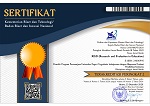Enhancing the five-tier diagnostic test on cell concepts through Rasch model analysis
DOI:
https://doi.org/10.21831/reid.v11i1.87212Keywords:
Rasch model, five tier diagnostic test, cell concept, misconceptionAbstract
Misconceptions in biology can prevent students from gaining a deeper understanding of biological concepts. There is a five-tier diagnostic test that can explore the misconceptions experienced by students. This research aims to develop a five-tier diagnostic test that is feasible to use to identify student misconceptions with Rasch model analysis. The research method used was quantitative descriptive, and the sample was 103 people with a purposive sampling technique, which is a purposeful sampling technique, namely, the school that is the research location, experiencing misconceptions related to the concept of cells. Based on the results of the study, it was found that the five-tier diagnostic test developed was very feasible to use as an instrument to identify students' misconceptions on the concept of cells. Each indicator is represented by several items that have been tested for validity, reliability, difficulty level and differentiation using Rasch model analysis with the help of the Winsteps program. Based on the analysis with the Rasch model, out of 36 items that were externally validated, 23 items were obtained that met the eligibility criteria and were declared valid for implementation.
References
Anam, R. S., Widodo, A., Sopandi, W., & Wu, H. K. (2019). Developing a five-tier diagnostic test to identify students’ misconceptions in science: An example of the heat transfer concepts. Elementary Education Online, 18(03), 1014-1029.
Anderson, L. W. & Krathwohl, D. R. (2014). Kerangka landasan untuk pembelajaran pengajaran dan asesmen (A. Prihantoro, trans.). Pustaka Pelajar.
Bond, T. G., & Fox, C. M. (2015). Applying the Rasch model: Fundamental measurement in the human sciences (3rd ed.). Routledge. https://doi.org/10.4324/9781315814698
Boone, W. J. (2017). Rasch analysis for instrument development: Why, when, and how? CBE-Life Sciences Education, 15(4), 1-7. https://doi.org/10.1187/cbe.16-04-0148
Boone, W. J., Staver, J. R., & Yale, M. S. (2014). Rasch analysis in the human sciences. Springer. https://doi.org/10.1007/978-94-007-6857-4
Brown, M. H., & Schwartz, R. S. (2009). Connecting photosynthesis and cellular respiration: Preservice teachers’ conceptions. Journal of Research in Science Teaching, 46(7), 791 – 812. https://doi.org/10.1002/tea.20287
Chang, C. Y., Yeh, T. K., & Barufaldi, J. P. (2010). The positive and negative effects of science concept tests on student conceptual understanding. International Journal of Science Education, 32(2), 265-282. https://doi.org/10.1080/09500690802650055
Dikmenli, M. (2010). Misconceptions of cell division held by student teachers in biology: A drawing analysis. Scientific Research and Essays, 5(2), 235–247. https://academicjournals.org/article/article1380539915_Dikmenli.pdf
Erfan, M., Maulyda, M. A., Hidayati, V. R., Astria, F. P., & Ratu, T. (2020). Analisis kualitas soal kemampuan membedakan rangkaian seri dan paralel melalui teori tes klasik dan model Rasch. Indonesian Journal of Educational Research and Review, 3(1), 11–18. https://ejournal.undiksha.ac.id/index.php/IJERR/article/view/24080/pdf
Ermawati, F. U., Anggrayni, S., & Isfara, L. (2019). Misconception profile of students in senior high school IV Sidoarjo East Java in work and energy concepts and the causes evaluated using four-tier diagnostic test. Journal of Physics: Conference Series, 1387, 012062. https://doi.org/10.1088/1742-6596/1387/1/012062
Fariyani, Q., Rusilowati, A., & Sugianto. (2015). Pengembangan four-tier diagnostic test untuk mengungkap miskonsepsi fisika siswa SMA kelas X. Journal of Innovative Science Education, 4(2), 41–49.
Friatma, A., & Anhar, A. (2019). Analysis of validity, reliability, discrimination, difficulty and distraction effectiveness in learning assessment. Journal of Physics: Conference Series, 1387(1), 012063. https://doi.org/10.1088/1742-6596/1387/1/012063
Gurel, D. K., Eryilmaz, A., & McDermott, L. C. (2015). A review and comparison of diagnostic instruments to identify students’ misconceptions in science. Eurasia Journal of Mathematics, Science and Technology Education, 11(5), 990–1008. https://doi.org/10.12973/eurasia.2015.1369a
Ibrahim, N. L., Laliyo, L. A. R., Hafid, R., Panigoro, M., & Bumulo, F. (2024). Applying diagnostic assessment with Rasch analysis to measure students' basic understanding of economics. JETL (Journal of Education Teaching and Learning), 9(2), 1-7. http://dx.doi.org/10.26737/jetl.v9i2.5376
Koray, C. Ö. & Bal, Ş. (2002). Misconceptions in science teaching and conceptual change strategy. Gazi University Kastamonu Education Journal, 10(1), 83-90. https://academicjournals.org/journal/ERR/article-full-text-pdf/ADB2D5B4634
Köse, S. (2008). Diagnosing student misconceptions: Using drawings as a research method. World Applied Sciences Journal, 3(2), 283-293. https://idosi.org/wasj/wasj3(2)/20.pdf
Kurnaz, M. A. & Eksi, C. (2015). An analysis of high school students' mental models of solid friction in physics. Educational Sciences: Theory and Practice, 15(3), 787-795. https://jestp.com/article-detail/?id=675
Lailiyah, S. & Ermawati, F. U. (2020). Materi gelombang bunyi: Pengembangan tes diagnostik konsepsi berformat Five-Tier, uji validitas dan reliabilitas serta uji terbatas. Jurnal Pendidikan Fisika Tadulako Online (JPFT), 8(3), 104-119.
Nuryanti, S., Masykuri, M., & Susilowati, E. (2018). Analisis Iteman dan model Rasch pada pengembangan instrumen kemampuan berpikir kritis peserta didik sekolah menengah kejuruan. Jurnal Inovasi Pendidikan IPA, 4(2), 224-233. https://doi.org/10.21831/jipi.v4i2.21442
Peşman, H. & Eryilmaz, A. (2010). Development of a three-tier test to assess misconceptions about simple electric circuits. Journal of Educational Research, 103(3), 208-222. https://doi.org/10.1080/00220670903383002
Quaigrain, K., & Arhin, A. K. (2017). Using reliability and item analysis to evaluate a teacher-developed test in educational measurement and evaluation. Cogent Education, 4(1), 1301013. https://doi.org/10.1080/2331186X.2017.1301013
Rahma, B., Zaki, M., Boujemaa, A., Nadia, B., & Lhoussaine, M. (2022). University students’ knowledge and misconceptions about cell structure and functions. European Journal of Education Studies, 9(10), 121-138. http://dx.doi.org/10.46827/ejes.v9i10.4494
Ramadhani, N. N. & Ermawati, F. U. (2020). Five-tier diagnostic test instrument for uniform circular motion concepts: Development, validity, reliability and limited trials. Jurnal Pendidikan Fisika, 9(1), 4763-4776.
Ramadhan, A. F., & Hidayatullah, R. S. (2023). Analisis kualitas butir soal ujian satuan pendidikan (USP) materi C2 teknik pemesinan kelas XII di SMK PGRI 1 Lamongan melalui model Rasch. Jurnal Pendidikan Teknik Mesin (JPTM), 12(3), 1–10. https://ejournal.unesa.ac.id/index.php/jurnal-pendidikan-teknik-mesin/article/view/56146
Rusilowati, A. (2015). Pengembangan tes diagnostik sebagai alat evaluasi kesulitan belajar fisika. Prosiding Seminar Nasional Fisika dan Pendidikan Fisika (SNFPF) ke-6 2015 (pp. 1-10). Program Studi Pendidikan Fisika, Universitas Negeri Semarang.
Sari, E. D. K. & Mahmudi, I. (2024). Analisis pemodelan Rasch pada assessment pendidikan (Analisis dengan menggunakan aplikasi Winstep). PT. Pena Persada Kerta Utama.
Silaban, O. R. (2021). Analisis miskonsepsi siswa pada materi sel sebagai unit terkecil kehidupan di kelas XI IPA SMA Negeri 1 Pagaran T.P 2020/2021. Undergraduate thesis, Universitas Negeri Medan, Medan.
Streiner, D. L. (2010). Starting at the beginning: An introduction to coefficient alpha and internal consistency. Journal of Personality Assessment, 80(1), 99-103. https://doi.org/10.1207/S15327752JPA8001_18
Sumintono. B, & Widhiarso, W. (2015). Aplikasi pemodelan RASCH pada assessment pendidikan. Trim Komunikata.
Suwono, H., Prasetyo, T. I., Lestari, U., Lukiati, B., Fachrunnisa, R., Kusairi, S., Saefi, M., Fauzi, A., & Atho’Illah, M. F. (2021). Cell biology diagnostic test (CBD-Test) portrays pre-service teacher misconceptions about biology cell. Journal of Biological Education, 55(1), 1-24. https://doi.org/10.1080/00219266.2019.1643765
Tambo, E. M. Z., Mukaro, J. P., & Mahaso, J. (2003). Some misconceptions on cell structure and function held by a-level biology students: Implications for curriculum development. Zimbabwe Journal of Educational Research, 15(2), 122–131. https://opendocs.ids.ac.uk/ndownloader/files/48257272
Tavakol, M., & Dennick, R. (2012). Psychometric evaluation of a knowledge based examination using Rasch analysis: An illustrative guide: AMEE Guide No. 72. Medical Teacher, 35(1), e838–e848. https://doi.org/10.3109/0142159X.2012.737488
Tekkaya, C. (2002). Misconceptions as barrier to understanding biology. Hacettepe Üniversitesi Eğitim Fakültesi Dergisi, 23(23), 259-266. http://www.efdergi.hacettepe.edu.tr/yonetim/icerik/makaleler/971-published.pdf
Wandersee, J. H., Mintzes, J. J., & Novak, J. D. (1994). Research on alternative conceptions in science. In D. L. Gabel (Eds.), Handbook of research on science teaching and learning (pp. 177-210). McMillan.
Zimmerman, D. W. & Williams, R. H. (2003). A new look at the influence of guessing on the reliability of multiple-choice tests. Applied Psychological Measurement, 27(5), 357-371. https://doi.org/10.1177/0146621603254799
Zulfianto, M. R. & Abduh, M. (2023). How do science content misconceptions occur in primary school teachers with teaching certificates?. Mimbar Sekolah Dasar, 10(3), 595-613. https://doi.org/10.53400/mimbar-sd.v10i3.62887
Downloads
Published
How to Cite
Issue
Section
Citation Check
License
Copyright (c) 2025 REID (Research and Evaluation in Education)

This work is licensed under a Creative Commons Attribution-ShareAlike 4.0 International License.
The authors submitting a manuscript to this journal agree that, if accepted for publication, copyright publishing of the submission shall be assigned to REID (Research and Evaluation in Education). However, even though the journal asks for a copyright transfer, the authors retain (or are granted back) significant scholarly rights.
The copyright transfer agreement form can be downloaded here: [REID Copyright Transfer Agreement Form]
The copyright form should be signed originally and sent to the Editorial Office through email to reid.ppsuny@uny.ac.id

REID (Research and Evaluation in Education) by http://journal.uny.ac.id/index.php/reid is licensed under a Creative Commons Attribution-ShareAlike 4.0 International License.







.png)





